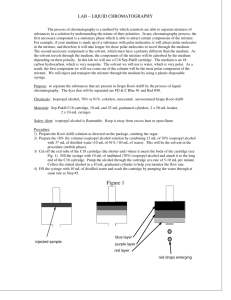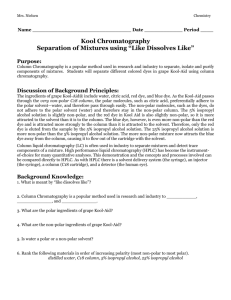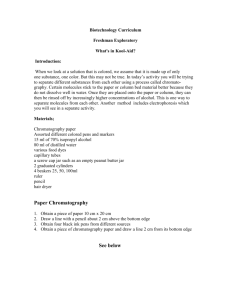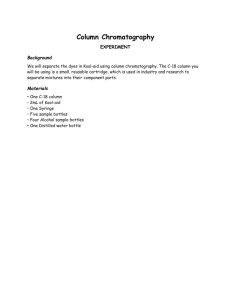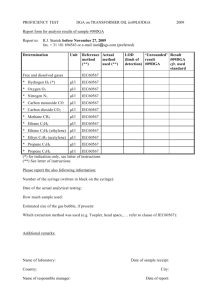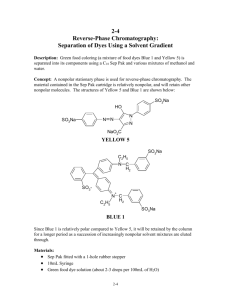Kool Chromatography - Mrs. Nielsen Science
advertisement
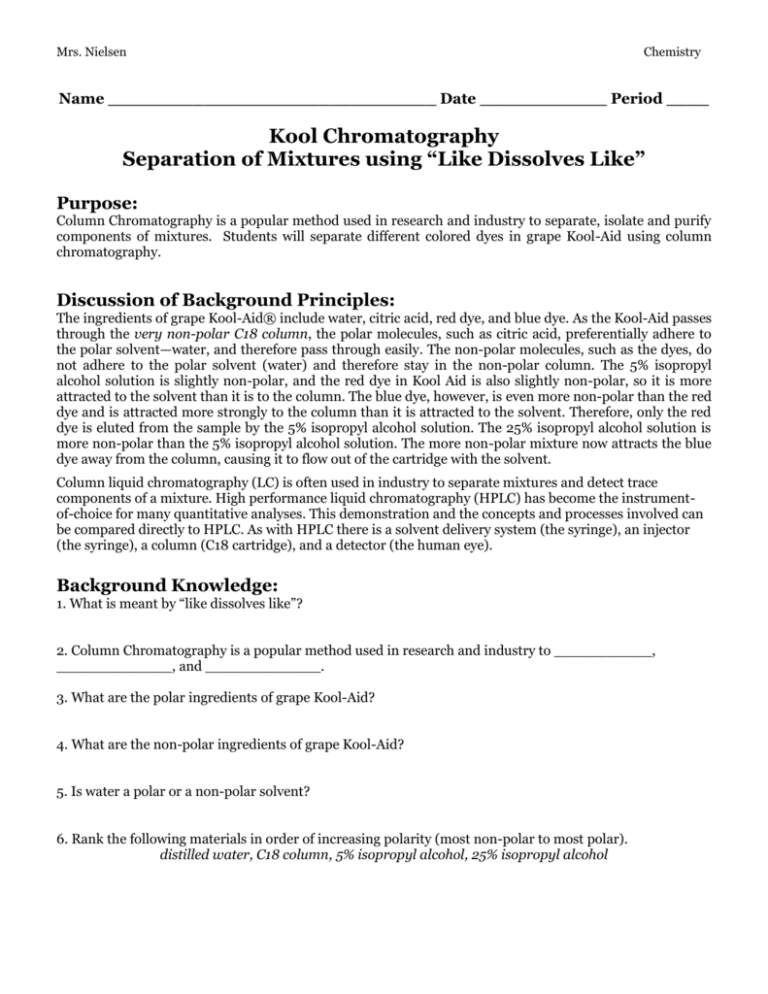
Mrs. Nielsen Chemistry Name _______________________________ Date ____________ Period ____ Kool Chromatography Separation of Mixtures using “Like Dissolves Like” Purpose: Column Chromatography is a popular method used in research and industry to separate, isolate and purify components of mixtures. Students will separate different colored dyes in grape Kool-Aid using column chromatography. Discussion of Background Principles: The ingredients of grape Kool-Aid® include water, citric acid, red dye, and blue dye. As the Kool-Aid passes through the very non-polar C18 column, the polar molecules, such as citric acid, preferentially adhere to the polar solvent—water, and therefore pass through easily. The non-polar molecules, such as the dyes, do not adhere to the polar solvent (water) and therefore stay in the non-polar column. The 5% isopropyl alcohol solution is slightly non-polar, and the red dye in Kool Aid is also slightly non-polar, so it is more attracted to the solvent than it is to the column. The blue dye, however, is even more non-polar than the red dye and is attracted more strongly to the column than it is attracted to the solvent. Therefore, only the red dye is eluted from the sample by the 5% isopropyl alcohol solution. The 25% isopropyl alcohol solution is more non-polar than the 5% isopropyl alcohol solution. The more non-polar mixture now attracts the blue dye away from the column, causing it to flow out of the cartridge with the solvent. Column liquid chromatography (LC) is often used in industry to separate mixtures and detect trace components of a mixture. High performance liquid chromatography (HPLC) has become the instrumentof-choice for many quantitative analyses. This demonstration and the concepts and processes involved can be compared directly to HPLC. As with HPLC there is a solvent delivery system (the syringe), an injector (the syringe), a column (C18 cartridge), and a detector (the human eye). Background Knowledge: 1. What is meant by “like dissolves like”? 2. Column Chromatography is a popular method used in research and industry to ___________, _____________, and _____________. 3. What are the polar ingredients of grape Kool-Aid? 4. What are the non-polar ingredients of grape Kool-Aid? 5. Is water a polar or a non-polar solvent? 6. Rank the following materials in order of increasing polarity (most non-polar to most polar). distilled water, C18 column, 5% isopropyl alcohol, 25% isopropyl alcohol Mrs. Nielsen Chemistry Materials: 70% isopropyl alcohol 25% isopropyl alcohol 5% isopropyl alcohol distilled water partitioned petri dish syringe C-18 column Grape Kool Aid Safety Precautions: 1. Isopropyl alcohol solution is a flammable liquid; keep away from open flame 2. Wear chemical goggles Procedure: *** Note: it is VERY important that you ALWAYS attach the long end of the C18 cartridge toward the syringe 1. First, you will “fix” or pretreat the C18 cartridge. Draw 10 mL of the 70% isopropyl alcohol solution into the syringe. Twist the C18 cartridge snugly into place (long end toward the syringe). Press the plunger to expel the isopropyl alcohol solution out of the syringe through the column INTO THE SINK. 2. Remove the C18 cartridge from the syringe. Repeat step 1 using 10 mL of distilled water in place of the 70% isopropyl alcohol solution. 3. Remove the C18 cartridge from the syringe. Draw 10 mL of the grape Kool-Aid from into the syringe. 4. Place the cartridge back on the syringe (long end toward the syringe) and force the Kool-Aid through the column and into a clean section on the partitioned petri dish. Notice the clear solution that elutes (or exits) from the column. 5. Again, remove the cartridge from the syringe. (If there is any grape Kool-Aid left in the syringe, rinse the syringe with 5% isopropyl alcohol first and pour into the sink.) Draw 10 mL of 5% isopropyl alcohol solution into the syringe and place the cartridge back on the syringe. 6. Force the 5% isopropyl alcohol solution through the column into a clean well in the petri dish. Note the red-colored solution that elutes from the column. 7. Remove the cartridge from the syringe and draw 10 mL of 25% isopropyl alcohol solution into the syringe. Replace the cartridge, long end toward the syringe. 8. Force the 25% isopropyl alcohol solution through the column into a clean well on the petri dish. Note the blue- colored solution that elutes from the column. 9. Before you clean up, draw a picture of what your petri dish looks like (see observations section). Then pour the contents of the petri dish into the sink and rinse with water. 10. Clean your C18 column for the next class by repeating steps 1 and 2. Mrs. Nielsen Chemistry Observations: Draw and color a picture of your partitioned petri dish in the space below. Label the contents of each section. Discussion Questions: 1. Using complete sentences, describe what happened in this activity. 2. The C18 cartridge is very non-polar. Rank the three solutions used to separate the Kool-Aid: water, 5% isopropyl alcohol, and 25% isopropyl alcohol, in order of increasing polarity from the (most non-polar to the most polar). 3. Water, 5% isopropyl alcohol, and 25% isopropyl alcohol were passed through the column in that order. Based on your observations and what you know about the polarity of the solutions, rank the ingredients of Kool-Aid: citric acid, blue dye, and red dye, in order of increasing polarity. 4. High-Performance liquid chromatography, also known as HPLC, is often used in scientific laboratories for quantitative analyses. HPLC requires the use of a solvent delivery system, an injector, a column, and a detector. This activity is comparable to HPLC. What is the equivalent of each of those materials in this activity? Solvent delivery system: Injector: Column: Detector: 5. Using the knowledge you gained from this activity, explain how detergents work using the concept of “like dissolves like”.
